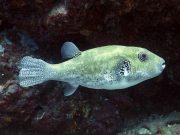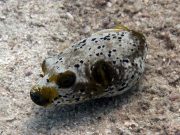Tauchen mit Kugelfische
Meeresleben von Lanta | Tetraodontidae
Kugelfische sind bei Tauchausflügen vor Koh Lanta an allen Korallenriffen häufig anzutreffen. Sie haben in der Regel runde Gesichter, spitz zulaufende Körper und große Augen und sind zwischen 2 cm und etwa 1 m lang. Kugelfische sind beim Tauchen rund um Koh Lanta leicht zu entdecken, gehören jedoch zu den giftigsten Fischen im Meer und sollten nicht gegessen werden.
Kugelfische können Wasser und manchmal auch Luft schlucken, um ihren Körper bei Gefahr zu einem riesigen Ball aufzublähen. Es wird angenommen, dass sie diese Taktik als Selbstverteidigungsmethode entwickelt haben, da sie sehr schlecht schwimmen können.
Ein Raubtier, das es schafft, einen Kugelfisch zu fangen, bevor er sich aufbläst, wird sich nicht lange glücklich schätzen können. Fast alle Kugelfische enthalten 'Tetrodotoxin', ein Gift, das sie für die meisten Raubtiere tödlich macht. Es kommt je nach Art in ihren Organen, ihrer Haut und ihren Stacheln vor. Nur wenige Tiere sind gegen das Gift immun, darunter Haie und Seeschlangen. Für Menschen ist es tödlich, da es bis zu 1.200 Mal giftiger ist als Zyanid und es kein bekanntes Gegenmittel gibt. Ein einziger Kugelfisch enthält genug Gift, um 30 erwachsene Menschen zu töten!
Kugelfische haben dicht gepackte Zähne, die ein zusammengewachsenes, schnabelähnliches Aussehen haben. Diese sehr scharfen Zähne werden verwendet, um Weichtiere aufzubrechen, Wirbellose zu fressen und Algen abzukratzen. Es wird angenommen, dass sie ihr tödliches Gift aus den Bakterien in ihrer Nahrung synthetisieren.
Wenn ein Kugelfisch geschlechtsreif wird, führt das Männchen das Weibchen in Ufernähe, wo sie nur 3 bis 7 Eier ablegen und befruchten. Die Jungtiere bleiben hier, bis sie groß genug sind, um sich dem Riff anzuschließen.
5 Arten auf dieser Seite gefunden:
Blackspotted Pufferfish
(Arothron nigropunctatus)
The blackspotted, or dog-face puffer is a common sight at all of our dive sites and easy to identify. This small fish has no scales and grows up to 33 cm, but more commonly observed around 20 cm. Sometimes seen alone, sometimes in pairs. This fish has a short snout, no pelvic fin and both a small dorsal and anal fin.

Arothron nigropunctatus @ Koh Haa
Blackspotted pufferfish colouration is highly variable, greyish, bluish, blackish, yellowish, however they all have a few common markings such as black lips, black around the pectoral fin base and scatterings of different sized black spots on the body.
Instead of "teeth," blackspotted puffers have 4 strong teeth in a beak-like structure which they use to crush crustaceans and mollusks, crunch sponges and the tips of branching corals.
Starry Pufferfish
(Arothron stellatus)

Arothron stellatus @ Koh Haa
The starry pufferfish is the largest of all puffers, growing up to 1.2m. This fish has no scales, with the body covered with prickles. This fish has a short snout, no pelvic fin and both a small dorsal and anal fin.
Adults are white with many small black spots, juveniles have fewer, larger spots. Young fish are orange with small black spots and black stripes on the belly, becoming spots as they age.
Usually seen alone, the starry puffer feeds on sea urchins, starfish, sponges, crabs, corals and algae. Sometimes seen swimming high above the corals or seabed. The starry puffer is extremely poisonous, and tetrodotoxin may occur in the muscle, intestine, liver, gonads and skin. Do not try to eat this fish.
Blue-spot Pufferfish
(Arothron caeruleopunctatus)

Arothron caeruleopunctatus @ Koh Haa
The Blue-spot Pufferfish has a yellowish, brown to grey back, lighter below, and covered in small white to blue spots.
There are alternating dark and light rings around the eyes, and the pectoral fin base has a black patch with white spots.
As with other Pufferfishes, the Blue-spot Pufferfish has a small dorsal and anal fin and the teeth are fused into four beak-like parts. The Blue-spot Pufferfish grows to 70 cm.
Scribbled Pufferfish
(Arothron mappa)

Arothron mappa @ Koh Haa
The scribbled, or 'map' puffer is a medium size fish growing up to 65 cm, but often observed smaller than this.
The background coloration is whitish with dense network of black broken lines and lines radiating from the eyes.
The scribbled pufferfish has a large black blotch around the gill opening, and a black blotch on the lower side.
As with the other puffers listed here, this fish has no scales, with the body covered with prickles.
This fish has a short snout, four beak-like teeth, no pelvic fin and both a small dorsal and anal fin. It is also highly toxic.
Spotted Toby
(Canthigaster solandri)

Canthigaster solandri @ Koh Haa
The Spotted Toby has a brownish body colour, covered with white to blue to green spots.
There are white to blue to green line markings on the snout and back. There is on ocellated spot on the dorsal fin base.
The Spotted Toby grows to 10 cm and is found in sheltered reef areas and often found in pairs.
The Spotted Toby fish feeds on algae, coral polyps and bottom-dwelling invertebrates such as molluscs (slugs & snails), echinoderms (sea urchins, sea stars) and polychaetes (bristle worms).
Tauchen mit Kugelfische rund um Koh Lanta
Tauch- und Schnorchelausflüge
Wenn Sie gerne die Gelegenheit hätten, Kugelfische auf einem unserer täglichen Tauchausflüge während der Hochsaison von Koh Lanta aus zu sehen, dann senden Sie uns eine E-Mail an info@diveandrelax.com.
Nehmen Sie an unseren Speedboot-Tauchausflügen in der Hochsaison zu einigen der besten Tauchplätze Thailands teil und genießen Sie kleine Gruppen, kurze Fahrzeiten und einen Fokus auf hervorragenden persönlichen Service, Sicherheit und Spaß.
Noch kein zertifizierter Taucher? Lernen Sie auf Koh Lanta das Tauchen mit dem 3-tägigen SSI Open Water Diver Kurs.
Buchen Sie online und sparen Sie 10% auf Tauchausflüge und Tauchkurse auf Koh Lanta.
Weitere Informationen
Indo-Pazifische Meereslebewesen-Führer
- Allen, G., Steene, R., Humann, P., DeLoach, N. (2003) Reef Fish Identification, Tropical Pacific. Jacksonville, FL., USA: New World Publications, Inc., ISBN 1-878348-36-1.
- Humann, P., DeLoach, N., (2010) Reef Creature Identification, Tropical Pacific. Jacksonville, FL., USA: New World Publications Inc., ISBN 978-1-878348-44-9
- Debelius, H. (2013) Indian Ocean Reef Guide. Frankfurt, Germany: IKAN - Unterwasserarchiv, ISBN 978-3-939767-52-7.
- Debelius, H. (2004) Nudibranchs and Sea Snails, Indo-Pacific Field Guide. Frankfurt, Germany: IKAN - Unterwasserarchiv, ISBN 3-925919-51-1
- Erhardt, H., Knop, D. (2015) Corals Indo-Pacific Field Guide. Frankfurt, Germany: IKAN - Unterwasserarchiv, ISBN 3-925919-69-4.
- Veron J.E.N., Stafford-Smith M.G., Turak E. and DeVantier L.M. (2016). Corals of the World
Weitere Referenzen zu Meereslebewesen und weitere Informationen


